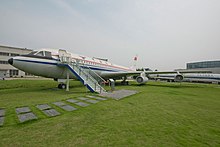Shanghai Y-10
| Shanghai Y-10 | |
|---|---|
 Model of a Y-10 |
|
| Type: | Airliner |
| Design country: | |
| Manufacturer: | |
| First flight: |
September 26, 1980 |
| Number of pieces: |
3 |
The Shanghai Y-10 was a four-engine passenger aircraft produced by the Chinese manufacturer Shanghai Aircraft (now Shanghai Aviation Industrial Company ). Development began in August 1970 and the first flight took place in 1980. The project was ended in 1983 and the only airworthy prototype was parked in 1984.
history
After relations with the West had improved, the People's Republic of China acquired Boeing 707 aircraft from 1972 . At the same time, the state commissioned a comparable model that was supposed to do without third-party components if possible. The aim was to demonstrate the capabilities of Chinese industry and gain experience in building large aircraft.
The Y-10 was externally very similar to the Boeing 707 and initially also took over its Pratt & Whitney JT3D-7 engine , as the newly developed Shanghai WS8 turbofans had not yet received approval. The maximum capacity was 178 passengers, with normal seating it fell to 124 passengers. The cockpit crew consisted of five people.
Three prototypes were built. The first was used exclusively as a static break cell. The second aircraft was intended for the test flights and flew for the first time on September 26, 1980. The third aircraft was used to determine the fatigue failure behavior. By the time it was taken out of service in 1984, the second prototype had completed 130 flights with a total duration of 170 hours. The development cost was 537.7 million yuan (about $ 315 million in 1981). The machine with the designation B-0002 is now at the edge of the Dachang Airbase ( location ) (Chinese 上海 大 场 机场, Pinyin : Shànghǎi Dàcháng Jīcháng ) near Shanghai .
After the first flight, a debate arose about the purpose of the project. The Y-10 was based on a design concept that was now thirty years old. The supporters at the top had been replaced by new, less isolationist-minded people.
In 1983 the project was canceled. The reasons given were the high development costs and the low market opportunities of the model. In 1985, the manufacturer began licensed production of McDonnell Douglas MD-80 .
A model of the Y-10 was presented as an airborne early warning system . This was very reminiscent of the Boeing E-3 , but was never implemented.
Technical specifications
| Parameter | Data |
|---|---|
| crew | 5 |
| Passengers | 124-178 |
| length | 42.93 m |
| span | 42.24 m |
| height | 13.42 m |
| Takeoff mass | 110,227 kg |
| Top speed | 974 km / h |
| Service ceiling | 12,000 m |
| Range | 8,300 km |
| Engines | four WS-8 (imitation of ducted turbines Pratt & Whitney JT3D- 7) |
See also
Web links
Individual evidence
- ↑ Jefim Gordon , Dmitri Komissarow: Chinese Aircraft . Hikoki Publications, Manchester 2008. ISBN 978-1-902109-04-6
- ↑ Jefim Gordon, Dmitri Komissarow: Chinese Aircraft . Hikoki Publications, Manchester 2008, p. 230. ISBN 978-1-902109-04-6
- ↑ Jefim Gordon, Dmitri Komissarow: Chinese Aircraft . Hikoki Publications, Manchester 2008, p. 230, ISBN 978-1-902109-04-6

